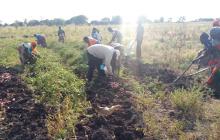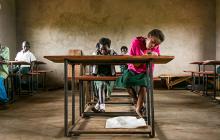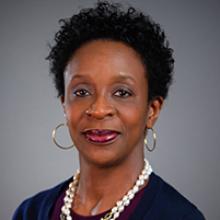Seeing the Faces Behind the Data
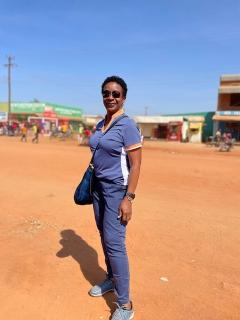
Traveling through Tanzania and Zambia was a magical experience. The skies were a breathtaking, bright open blue. The vast fields of maize, cassava, sweet potatoes, and sunflowers—used for sunflower oil—suggested endless bounty. The majestic baobab trees dotting the landscape felt like our constant travel companions across many villages.
I experienced all these things and more when I joined a recent AIR Board of Directors trip to visit projects that we support in these two countries. When we spoke with two female farmers in Iselamagazi, Tanzania, their eyes shone with pride as they described their experiences and the challenges they overcame to become successful farmers in the region. They both grow orange-fleshed sweet potatoes, which have a fantastic nutritional profile. “I feel like I am nourishing my community,” one woman told me. “My everyday work in the soil will, eventually, help my friends and family live healthier lives. It is the most important thing I have ever done.”
As vice president and Chief Diversity, Equity, and Inclusion Officer, I have a bird’s eye view on the breadth and depth of our projects; in previous roles, I conducted technical assistance work in the fields of juvenile justice, children’s behavioral health, and more. I’ve been fortunate to see firsthand many different ways that AIR uses rigorous evidence to contribute to a better, more equitable world.

Even so, the May trip to Zambia and Tanzania was a revelation. On paper, I knew about the projects I was going to see from my colleagues in our international development division—their objectives, the way they used data, their measurable results. But the official project descriptions can’t convey the work behind the work, the collaborative partnerships that suffuse the work with cultural competence and local buy-in, and the faces and voices of the people directly impacted.
Our project on Neglected Crops and Maternal and Infant Health in Tanzania is a perfect example. On its face, this project can seem relatively simple. In Africa and southeast Asia, a lack of crop diversity is resulting in widespread vitamin A deficiencies. This is a serious public health issue, especially for pregnant women and infants, with adverse consequences that include weakened immune systems, night blindness, and maternal mortality. Therefore, the International Potato Center is incentivizing the production and consumption of the orange-fleshed sweet potato—a vitamin A powerhouse and superfood—in Shinyanga, Tanzania. So far, AIR’s mixed-methods evaluation of the project shows that a substantial share of farmers have adopted farming orange-fleshed sweet potatoes.
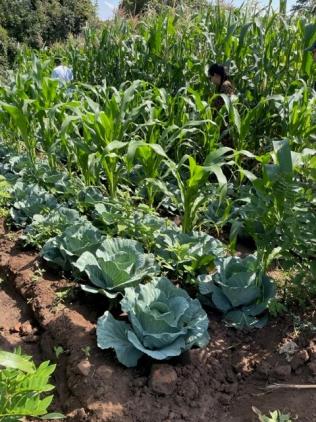
All of this can easily be gleaned from our website, and all of it matters. But there is so much more to this project than we can convey in a study summary. It takes enormous patience to see a project like this bear literal and metaphorical fruit: for farmers to grow the produce successfully, and eventually, to watch nutritional and health outcomes improve.
This project also requires collaborative partnerships on every level, with local experts who help ensure that our work fits well into their community. Meeting stakeholders of this project—from leaders at the Ministry of Agriculture to local farmers—helped demonstrate the scale of the cooperation needed. And it helped me understand that the project’s reach exceeds even the hoped-for nutritional outcomes—for example, the pride of local farmers, as described earlier. These kinds of outcomes, though harder to quantify, also matter.
In Zambia, we had the honor of visiting several schools that are part of the Impact Network’s eSchool 360 program. This promising educational approach for rural schoolchildren involves three elements: an e-learning technology component, ongoing teacher training and professional development, and community ownership among students in community schools in rural Zambia. AIR’s two-stage, mixed-methods evaluation examines both learning outcomes among students as well as the cost-effectiveness of those impacts. This project, which is supported by the AIR Equity Initiative, is designed to maximize data to promote effective educational interventions.
This kind of collaborative, culturally sensitive problem-solving is impossible without robust partnerships at every level—from the government, to educators, to the students themselves.
But again, there is so much behind-the-scenes, logistical work underlying any project, particularly one of this scale. Because this project evaluates a network of 63 schools, all of which are designed to serve rural children, our researchers spend countless hours traveling, often on unpaved roads or uncomfortable conditions. Seeing the project in person also shone a light on how researchers adapt to, and incorporate, local cultural norms. In Zambia, as in many countries, female menses are still stigmatized, which often forces girls to miss school for up to a week. To meet this need, women within the Impact Network have come together to sew reusable pads that can help keep them in school. This kind of collaborative, culturally sensitive problem-solving is impossible without robust partnerships at every level—from the government, to educators, to the students themselves. Behind the statistics about student outcomes are individual faces, young boys and girls, whose everyday lives look different because of this work.
AIR’s mission is to generate and use rigorous evidence that contributes to a better, more equitable world. Many people might focus on the words “rigorous evidence,” which is perfectly understandable. We are a research and technical assistance organization, after all, and we believe wholeheartedly in numbers and facts. But they tell an incomplete story. It takes people, like the individuals in Zambia and Tanzania who graciously shared their time with us, to breathe life into that story. If rigorous evidence is what we do, we must always remember that people are why we do it.
